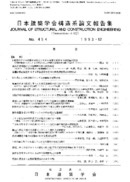406 巻
選択された号の論文の18件中1~18を表示しています
- |<
- <
- 1
- >
- >|
-
原稿種別: 表紙
1989 年 406 巻 p. Cover1-
発行日: 1989/12/15
公開日: 2017/12/25
PDF形式でダウンロード (53K) -
原稿種別: 表紙
1989 年 406 巻 p. Cover2-
発行日: 1989/12/15
公開日: 2017/12/25
PDF形式でダウンロード (53K) -
原稿種別: 付録等
1989 年 406 巻 p. App1-
発行日: 1989/12/15
公開日: 2017/12/25
PDF形式でダウンロード (131K) -
原稿種別: 目次
1989 年 406 巻 p. Toc1-
発行日: 1989/12/15
公開日: 2017/12/25
PDF形式でダウンロード (53K) -
原稿種別: 付録等
1989 年 406 巻 p. App2-
発行日: 1989/12/15
公開日: 2017/12/25
PDF形式でダウンロード (49K) -
原稿種別: 付録等
1989 年 406 巻 p. App3-
発行日: 1989/12/15
公開日: 2017/12/25
PDF形式でダウンロード (49K) -
原稿種別: 本文
1989 年 406 巻 p. 1-12
発行日: 1989/12/15
公開日: 2017/12/25
PDF形式でダウンロード (1287K) -
原稿種別: 本文
1989 年 406 巻 p. 13-23
発行日: 1989/12/15
公開日: 2017/12/25
PDF形式でダウンロード (1707K) -
原稿種別: 本文
1989 年 406 巻 p. 25-35
発行日: 1989/12/15
公開日: 2017/12/25
PDF形式でダウンロード (1117K) -
原稿種別: 本文
1989 年 406 巻 p. 37-43
発行日: 1989/12/15
公開日: 2017/12/25
PDF形式でダウンロード (837K) -
原稿種別: 本文
1989 年 406 巻 p. 45-54
発行日: 1989/12/15
公開日: 2017/12/25
PDF形式でダウンロード (736K) -
原稿種別: 本文
1989 年 406 巻 p. 55-68
発行日: 1989/12/15
公開日: 2017/12/25
PDF形式でダウンロード (1387K) -
原稿種別: 本文
1989 年 406 巻 p. 69-79
発行日: 1989/12/15
公開日: 2017/12/25
PDF形式でダウンロード (1363K) -
原稿種別: 本文
1989 年 406 巻 p. 81-92
発行日: 1989/12/15
公開日: 2017/12/25
PDF形式でダウンロード (1292K) -
原稿種別: 本文
1989 年 406 巻 p. 93-102
発行日: 1989/12/15
公開日: 2017/12/25
PDF形式でダウンロード (1010K) -
原稿種別: 本文
1989 年 406 巻 p. 103-111
発行日: 1989/12/15
公開日: 2017/12/25
PDF形式でダウンロード (1016K) -
原稿種別: 付録等
1989 年 406 巻 p. App4-
発行日: 1989/12/15
公開日: 2017/12/25
PDF形式でダウンロード (67K) -
原稿種別: 表紙
1989 年 406 巻 p. Cover3-
発行日: 1989/12/15
公開日: 2017/12/25
PDF形式でダウンロード (68K)
- |<
- <
- 1
- >
- >|
